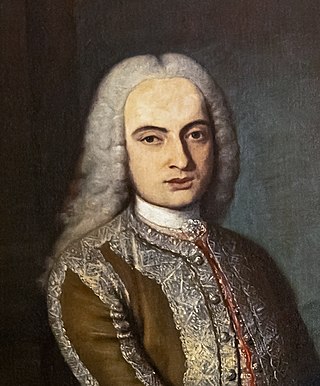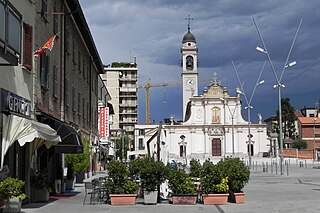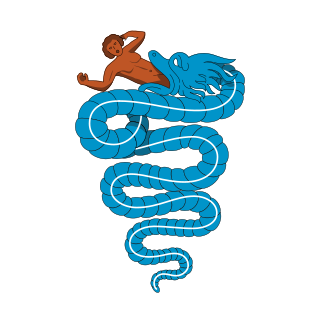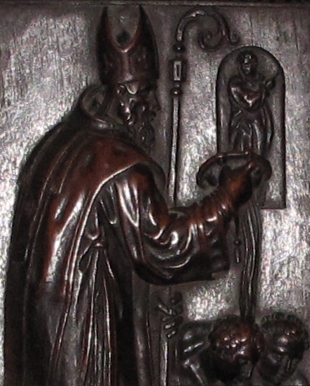
Sant'Ambrogio e Carlo al Corso is a basilica church in Rome, Italy, facing onto the central part of the Via del Corso. The apse of the church faces across the street, the Mausoleum of Augustus on Via di Ripetta.

Gian Rinaldo Carli (1720–1795), also known by other names, was an Italian economist, historian, and antiquarian.

Nabor and Felix were Christian martyrs thought to have been killed during the Great Persecution under the Roman emperor Diocletian. A tomb in Milan is believed to contain their relics.

Cinisello Balsamo is a comune (municipality) of about 75,200 inhabitants in the Metropolitan City of Milan, in the Italian region of Lombardy, about 10 kilometres (6 mi) northeast of Milan city center.

The Basilica of Sant'Ambrogio is an ancient Romanesque-style, Roman Catholic church in the center of Milan, region of Lombardy, Italy.

Maternus was Archbishop of Milan from c. 316 to c. 328. He is honoured as a Saint in the Catholic Church and his feast day is on July 18.

Monas was Bishop of Milan from the end 3rd-century to early 4th-century. He is honoured as a Saint in the Catholic Church and his feast day is on October 12.

Barona is a border district ("quartiere") of the city of Milan, Italy. It is part of the Zone 6 administrative division, and it is located south of the city centre. Its population can be roughly estimated to 85,000. It borders on the comunes of Buccinasco, Assago, and Corsico and the districts of Lorenteggio and Torretta. Its boundaries are marked by the Parco Agricolo Sud Milano nature reserve to the south, by the Naviglio Grande and Naviglio Pavese canals to the east and to the west, and by the Circonvallazione ring road to the north.

Sant'Ambrogio della Massima is an ancient Catholic church in rione Sant'Angelo, Rome, Italy. It is home to the General Curia of the Subiaco Cassinese Congregation of the Order of Saint Benedict.
Sant'Ambrogio may refer to the following entities in Italy:

Oh bej! Oh bej! is the most important and traditional Christmas fair in Milan, Italy. It is held from 7 December until the following Sunday. The fair is also informally known as the Fiera di Sant'Ambrogio.

The Lordship of Milan was a state in Northern Italy created in May 1259 following the election of Martino della Torre as lord of Milan. From 1259 to 1277 it was governed by the Della Torre family until, following the Battle of Desio, Napo della Torre was forced to yield his position to Ottone Visconti. The domination of the Visconti dynasty led to a series of territorial conquests that led the family to achieve the title of Dukes of Milan in 1395.

Caius was Bishop of Milan in early 3rd-century. He is considered by the Orthodox tradition the first Bishop of Milan in the 1st century. He is honoured as a saint in the Eastern Orthodox Church and the Roman Catholic Church and his feast day is on 27 September.
Lawrence I was Archbishop of Milan from 490 to c. 511. He is honoured as a saint in the Catholic Church and his feast day is July 25.

Mansuetus was Archbishop of Milan from 676 to 685. He is honoured as a saint in the Catholic Church.

The Pusterla di Sant’Ambrogio is a minor or secondary gate in the Medieval walls of Milan; the rebuilt Romanesque-style tower and pedestrian arches is located on Via Carducci #41, near the Castello Cova and some 50 meters west of the entrance of the Basilica di Sant'Ambrogio in the center of Milan, region of Lombardy, Italy.

Saint Ambrose is a small church which is an annex to the farmhouse that takes its name from it, in Brugherio, Italy.

Cascina Sant'Ambrogio is the oldest among the farmhouses in Brugherio, Italy. It is annexed to Saint Ambrose Church from which it takes its name.
The old farmhouses of Brugherio were agricultural structures typical of the Po-Valley in Lombardy, which derived its name from the surrounding areas, roughly corresponding to fractional towns in which Brugherio was divided. The union of the various small rural municipalities in 1866 gave birth to the municipality of Brugherio. Some fragmented towns are still visible, namely: Bindellera, Casecca, Cattoni, Comolli, Dorderio, Guzzina, Increa, Modesta, Moia, Occhiate, Pareana, San Cristoforo, Sant'Ambrogio, San Paolo and Torazza.
Enrico da Settala, sometimes anglicized Henry of Settala, was the archbishop of Milan from 1213 until his death.















